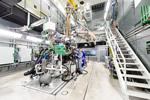 |
| MTU opened 9,000 sq.-meter facility with three test stands, each assigned 2,500-kW engines. Subsequent phases will see up to nine test stands, plus a supply network for alternative engine fuels. Engines to be tested and refined at the facility include the Series 1300, commonly spec’ed in front discharge mixer trucks. |
 |
Rolls-Royce Power Systems’ MTU business will continue to work with Daimler on developing and building high-speed Series 1000, 1100, 1300 and 1500 units that comply with the EU Stage V off-highway emissions standard. The engines deliver 100 to 480 kW and are to be available well ahead of the EU Stage V emissions standard scheduled for 2019. It will prescribe for engines, machinery and equipment a reduction not only in soot particulate mass but also number. MTU engines are to meet the more stringent emissions limits by deploying an additional diesel particulate filter. Further in-engine innovations will also be instrumental in lowering fuel consumption.
“Industrial engines account for a significant share of our business that we will continue to grow,” say Rolls-Royce Power Systems CEO Dr. Ulrich Dohle “By extending existing supply contracts, we are making industrial engines for all relevant emissions stages available to our customers on a long-term basis. At the same time, we can already unveil our solution for the new EU Stage V legislation. Furthermore, our customers can continue to enjoy all the benefits of high-volume production at Daimler.”
“We will be continuing our close partnership with MTU to consolidate our business in medium and heavy-duty commercial vehicle engines for use in off-highway applications,” adds Daimler Global Powertrain and Manufacturing Engineering Division head Dr. Frank Reintjes, crediting Daimler “products’ reliability, fuel efficiency and high quality standards” for MTU’s continuing endorsement.
$45M TEST FACILITY
Concurrent with the Daimler program, Rolls-Royce Power Systems opened a five-story facility at MTU headquarters in Friedrichshafen, Germany, geared to development of next-generation combustion engines. “This move is making space for new developments in every sense of the word. Technology on the combustion engine of the future is going to be even more complex than that of its predecessors, so we have to make absolutely sure that we have the capacity to carry out tests and trials on our new products reliably and intensively,” Dr. Dohle noted at the opening of the $45 million facility.
Rolls-Royce Power Systems will be using the research & development operation on existing engine series and to “break into new territories.” New combustion processes, advanced technologies for electronic regulation and control and, from mid-2016 forward, alternative fuels are some of the latest developments that will be put under scrutiny at the facility’s test stands. Among special features is a gallery above each test stand booth, contributing to exhaust aftertreatment system development.
“We are making a major research effort in this area because we want to develop diesel particulate filter and SCR technologies as far as we can ourselves,” Dr. Dohle observes. “That will put us in a position to provide customers with a complete systems package.”
Exhaust aftertreatment systems will enable engines to meet the strict emissions standards coming into force in the future. Ultra-modern test stands are key to tomorrow’s cutting edge technologies, MTU engineers contend, noting how chilling machines, heat exchangers, steam generators and various fuel formulations allow a whole spectrum of engine operation scenarios to be simulated—from biting cold to tropical humidity. Advanced measuring and analysis systems enable test stand technicians and development engineers to monitor results and document them precisely.
Sophisticated technologies also come into play in the way the test stands themselves are run, engineers note. In addition to conventional dynamometers, electrical gensets will also be used to simulate rapid load changes. The electrical power they deliver will also be fed into the facility’s own power grid.
